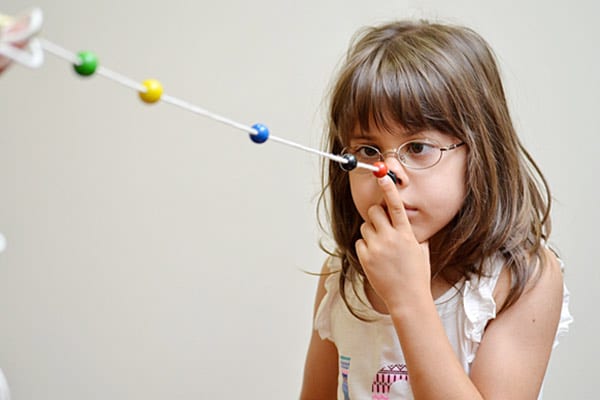
Home-Based Vision Therapy for Children
In the current pandemic situation, the world has changed where we spend most of our time on near vision dependent tasks and are more prone to develop non-strabismic binocular vision anomalies
Binocular vision is a type of vision where the two human eyes work together and perceive one single three-dimensional image. If the eyes are not aligned or coordinated to work together, the visual system won’t be able to pass adequate information to the brain and may lead to binocular vision disorders. It is very important in our daily life as it allows us to perceive depth and relationship between objects when we do our daily activities which are quite difficult to perform with only one eye. The disorders are broadly classified into non-strabismic (latent) and strabismic (manifest). Binocular vision disorders are amongst the most common visual disorders today.
Though a spectacle is the primary relief treatment for these problems but vision therapy is an adjunct that supplements office therapy, eliminating the symptoms and improving their quality of life.
Vision therapy (VT) is a therapeutic process where the visual system including eyes and part of the brain is stimulated and trained. Vision therapy can be either office-based or home-based depending on the patient’s severity and time commitment. Home-based vision therapy requires fewer office visits, requires fewer follow-up visits, requires no specialized equipment and is cheaper than office-based therapy.
Following are few disorders which can be treated with VT
- Strabismus (misalignment of eyes if not in large extent)- VT ( Stereogram, pencil push-up, Dot card, Brock string, Barrel card, Lifesaver card)
- Accomodation anamolies (focusing disorders)-VT( Distance/Near Hart chart , +/- lens Flippers)
- Oculomotor dysfunction (eye-tracking disorder)- VT (Sheet tracking exercise, Hart chart, Letter tracking i.e. Ann Arbor Letter tracking
- Amblyopia (lazy eye)- VT (Patching, Cognitive Therapy, miscellaneous task with patching, Home-based app for Amblyopia therapy,anti-supression exercise) exercises using red & green filter
- Other Problems (learning disabilities and acquired brain injury)
VERGECE EXERCISES
1) Pencil push-up test
Pencil push-ups treatment (PPT) is a commonly prescribed eye exercise approach for onvergence insufficiency. Patients hold the pencil with their arm outstretched and then slowly bring it close to their nose focusing at the pencil tip. The goal is to keep the pencil clear (not blurry) and single (not double) for as long as possible while moving the pencil close and
far from the nose.
2) Stereogram
Purpose
To achieve a stereoscopic (3D) image from the two images on the stereogram card.
- Hold card with images facing you at arm’s length at eye level.
- Place a pen against the card between the two images.
- Slowly move pen towards you looking at pen-tip constantly. It is important at this stage of the exercise not to look directly at the card look continuously at the pen.
- While looking at the pen as you move it slowly towards your nose, you should be aware of both the images becoming double and see 4 images
- Continue to slowly move the pen towards you and the 4 images should become 3 images with the middle image either appearing complete when using the cat card

3) Brock String
It is a common vision therapy tool, consisting of a white flexible string, approximately 10 - 15 feet in length, with colored wooden beads that can be moved to various positions along the length of the string. The Brock offers instant feedback to the participant if their eyes are working together to focus on an object at various distances. It is often used in vision therapy for patients with vergence disorders such as Convergence and divergence insufficiency.
When using the Brock string, one end is held at the tip of the nose, while the other is tied to a fixed point usually a doorknob. Three beads on the string are placed at different distances, and the patient must focus on each of the beads.
Advantages
These techniques are generally the least expensive therapy procedures. A sufficient variety of targets are available,and the techniques work well with shallow to moderate suppression. These techniques work especially well for convergence therapy.
4) Life Saver Cards
To improve or maintain the ability of the brain to merge two images (one from each eye) with the eyes converging.
Procedure
- Hold the opaque Lifesaver card at about 40 to 50cm.
- Hold a pencil in front of the card between the red and green circle at the bottom (see picture). Look at the tip of the pencil and keep it single. As you move it towards your nose the 2 circles will break apart and you will see a third circle in the middle.
- The third circle should NOT be red or green but a mixture of red & green.
- The middle circle should appear to be floating towards you.
- The words “Clear These Letters” should be clear with all the letters present.
- Try moving your head side to side, up and down and rotating whilst keeping the middle circle clear with all the letters present. 5. If you can do the bottom circle, work your way up to the top set of circles. You should be able to hold the middle circle clear and single for at least 5 seconds.
- Now repeat this without the aid of the pencil and continue for a few minutes a day for the time period recommended by your optometrist.
Conclusion
To get the effective and desired result, following things need to be maintained
- The Vision Therapy must be easy to use
- The purpose & procedure must be well explained by Optometrist and properly understood by patients & guardians
- High Motivation from both patient and the parents, is of great value







